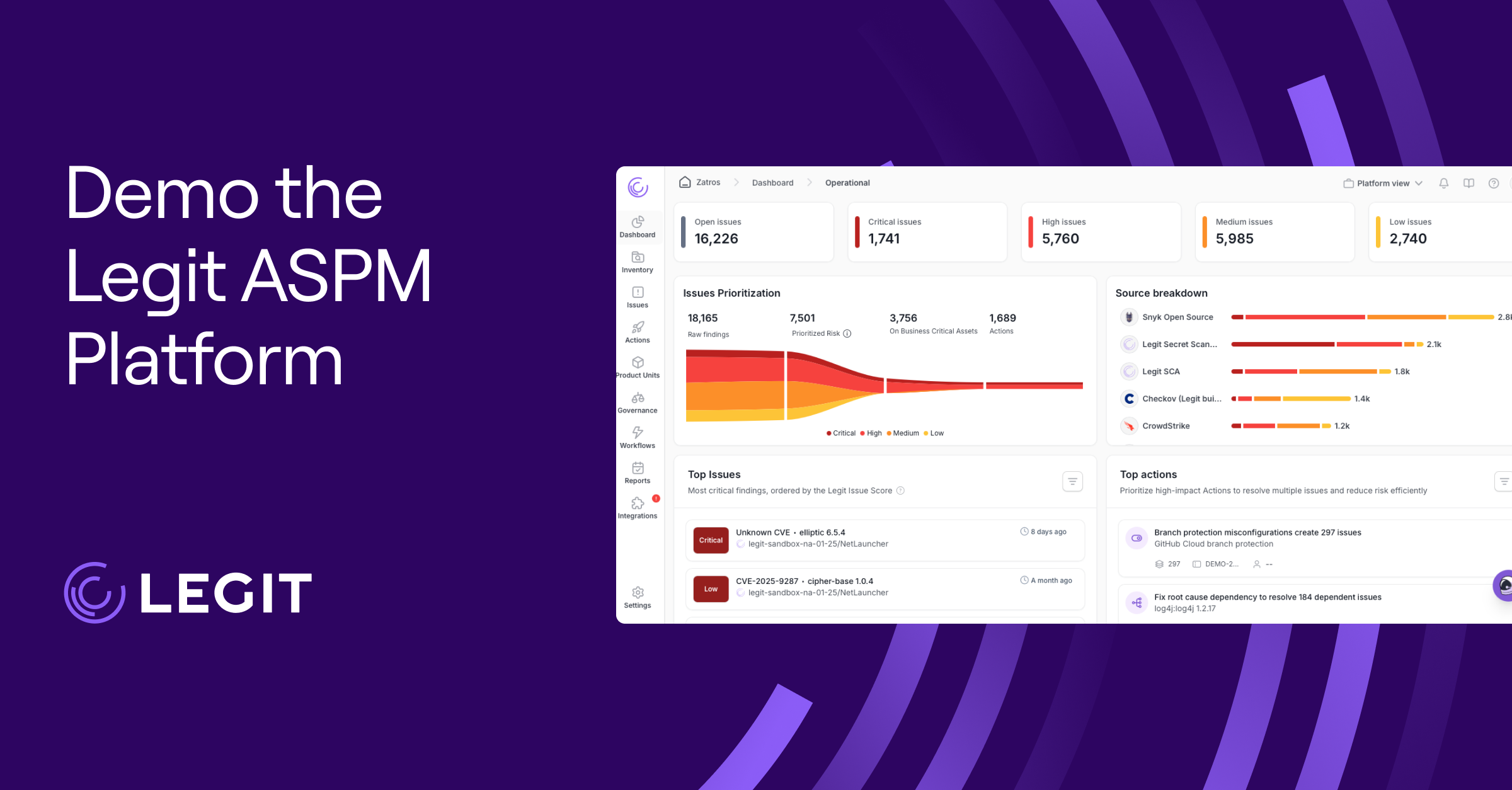As cyberthreats continue to spread, security professionals must take extra steps to secure data and applications. Strong application security controls can reduce or eliminate vulnerabilities, which leads to greater compliance and decreases the risks of breaches.
By embedding the right controls and standards throughout the software development lifecycle (SDLC), teams can protect sensitive data, maintain trust, and strengthen overall security posture. Here’s how application security controls work and how to implement them.
What Are Application Controls for Security?
Application security controls, or AppSec controls, are technical and procedural measures that limit applications from operating in a way that creates vulnerabilities. These controls act as countermeasures to reduce risk and help make sure that applications function securely.
While there are many different types of security controls, each falls into one of two main categories:
- Proactive controls prevent attacks before they begin by eliminating vulnerabilities and reducing the threat landscape.
- Reactive controls detect issues as they occur and take steps to mitigate associated risks or contain the impacts.
Alternatively, organizations might class the different types of controls as technical, operational, and administrative. Technical tools might include encryption, operational tools include incident response planning, and admin tools focus on governance and risk assessment.
8 Types of Application Security Controls
There are many different ways to categorize AppSec, but these are far more broad than other models. A more specialized list of the controls can help you better understand the available options.
1. Validity Checks
Validity checks serve as the first line of defense against malicious input. They create mechanisms to ensure that only the expected, appropriate, and safe data enters or leaves the application. Validity checks usually focus more on input validation to ensure proper data sanitization and formatting, which reduces the risks of SQL injection, cross-site scripting attacks, and corrupted outputs. Organizations can also use static analysis and testing tools to identify risks.
2. Access Controls
Have you ever received an error message when trying to access your bank account from overseas? That’s an example of access controls. These controls can restrict access to specific features—or an entire application—based on user roles and permissions. Measures like this reduce the risk of unauthorized activity and makes it more difficult for hackers to exploit weaknesses.
3. Encryption
Algorithms do more than just power AI and machine learning (ML). Security professionals also use them to encrypt data and implement secure software practices.
Strong encryptions protect everything from passwords to data in transit. They make it difficult for hackers to access data or systems without having the proper key to decode the information.
Key management is crucial for keeping encryption effective and is most commonly used in finance, healthcare, and the government.
4. Logging and Monitoring
Cybersecurity analysts spend hours each week combing through logs for suspicious behavior. Most use automated scanning and analysis tools—including some security applications powered by AI/ML—to sort through the information. The more data there is, the greater the opportunities for catching threats. Comprehensive logging and monitoring solutions also help companies generate logs for things like failed log-in attempts and critical system events, creating an audit trail for future problem-solving.
5. Firewalls and Intrusion Detection
Firewalls have been a mainstay of cybersecurity for decades, but AI and ML have boosted firewall capabilities to close loopholes and ensure effective configuration. Coupled with intrusion detection/prevention systems (IDS/IPS), firewalls provide a “protected perimeter” to strengthen web application security.
6. Error Handling
Error codes can leak sensitive information, so they should never release system architecture or source code. Security teams must implement proper error handling controls to limit what the system outputs and ensure that systems default to secure states when unexpected conditions occur. This assists usability and protects data.
7. Session Management
Session management controls create a secure user experience from the beginning to end of each session. This involves implementing mechanisms that validate the integrity of user sessions and prevent man-in-the-middle attacks or other forms of hijacking. Controls generally include session timeouts, secure tokens, and secure cookie configurations.
8. Security Testing Controls
Organizations should conduct regular testing to see how well systems hold up to attacks. Methods generally include:
- Penetration testing
- Dynamic Application Security Testing (DAST)
- Static Application Security Testing (SAST)
- Software composition analysis
Advantages of Application Security Controls
Your organization has a lot to gain from implementing AppSec controls. These multi-layered checkpoints secure applications and app data throughout the SDLC. Here are some of the benefits:
- Reduced risk of breaches: Controls help secure data at both the application and data level by blocking common attacks and using threat modeling to prepare for rarer risks.
- Improve compliance: Application software security compliance is especially critical for highly regulated industries like securities and investment, healthcare, and government services.
- Operational resilience: One study found that 58% of businesses impacted by ransomware had closed down since the attack. Blocking these and other types of attacks and creating contingency plans can help organizations weather attempted breaches.
- Support for DevSecOps: Tight controls align well with DevSecOps best practices, which embed security at every level of the development process. They also boost compliance and operational resilience.
- Enhanced user trust: Implementing Zero Trust and other frameworks tells users that you’re serious about protecting their data from unauthorized access.
4 Application Security Controls Frameworks to Know
Organizations often rely on established frameworks to guide their efforts to implement AppSec controls. These four provide a solid starting point:
- CIS Critical Security Controls: CIS controls are a predetermined set of 18 prioritized controls and best practices. They integrate well with DevSecOps workflows to improve security posture.
- NIST Cybersecurity Framework 2.0: This framework from the National Institute of Standards and Technology (NIST) takes a strong governance and risk management approach. It spreads its best practices across six main functions: identifying, protecting, detecting, responding, recovering, and governing.
- OWASP Proactive Controls: OWASP controls are more developer-centric and include a checklist of 10 critical security controls. It’s especially useful for software design and code reviews during the SDLC.
- ISO/IEC 27001: This is a global security standard for implementing security controls within information security management systems. Organizations can get ISO-certified to show compliance with secure application controls.
How to Implement Application Security Controls
Effective implementation requires more than just following a prescribed framework. Security professionals should analyze the current security environment to identify business needs, unique risks, and potential security gaps. The process generally involves:
- Identifying which applications can perform specific tasks and the resources they access
- Creating rules that govern the way the application functions and using technical, operational, and admin controls to enforce the governance framework
- Using version control systems to manage changes to application security rules
- Regularly evaluating, testing, and improving the rules and controls to ensure compliance with updated guidance and protection against new threats
Within organizations, leaders should also empower developers to ensure secure coding. Even small errors like forgetting to configure repositories as private or not encrypting sensitive data can lead to compliance issues and breaches.
Strengthen Your Application Security Controls With Legit Security
Legit Security acts as the foundation of your application security program. By bringing clarity and context to AppSec, the Legit ASPM platform helps teams find and fix true application risk faster. It consolidates all your AppSec findings into one place with the context needed to identify what to fix first and the AI-based remediation to fix it fast.
Build faster with Legit by leveraging real-time risk insights and compliance monitoring. Book a demo to get started.
Download our new whitepaper.


